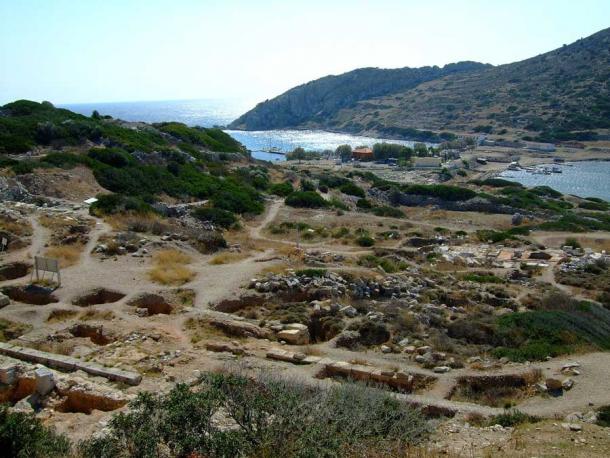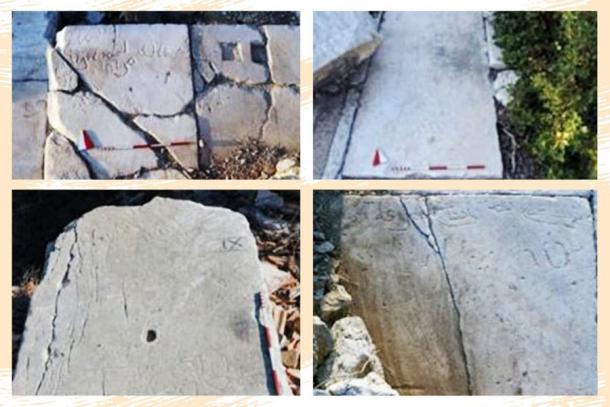Four Umayyad inscriptions inscribed on limestone and marble blocks have been discovered among the ruins of the 2,600-year-old city of Knidos in western Turkey. The four Umayyad inscriptions, from between 685 and 711 AD, were found during ongoing excavations at the Knidos site. The inscriptions included details of Umayyad expeditions to Istanbul, Hurriyet Daily News reports.
The excavations are being carried out by Selçuk University for the Ministry of Culture and Tourism, the Turkish Historical Society, and the General Directorate of Cultural Heritage and Museums. The head of the archaeological team of 40 geologists, architects, restorers, art historians, biologists, anthropologists and excavation workers is Professor Ertekin Doksanaltı from Selçuk University’s Archaeology Department.

The four Umayyad inscriptions were found at the ancient Anatolian port of Knidos, which is a fairly large archaeological site in southwestern modern-day Turkey. (Tischbeinahe / CC BY-SA 3.0 )
The Ancient City of Knidos and the New Umayyad Inscriptions
The port city of Knidos was founded by Greek settlers. As a trading hub in the region, it developed into an important political and cultural center after the fifth century BC. Daily Sabah reports that a medical school was once located in the city and its physicians were famous in the ancient world. With magnificent structures, a port street lined with columns, an agora, two ancient theaters and two ports, the city that has been dated to the first half of 2000 BC is a great draw for domestic and foreign tourists.
Knidos is also famous for having housed the (now extinct) statue of the Greek goddess Aphrodite , made by Praxiteles of Athens around the fourth century BC. The statue was renowned as the first full-sized Greek representation of the nude female form. It is known to us through the many surviving Roman copies.
The Umayyads ruled the city between 685 and 711 AD and this also sheds light on the recently discovered four Umayyad inscriptions. The dynasty was founded by Muʿāwiyah ibn Abī Sufyān, a contemporary of the prophet Muhammad from Mecca. The Umayyads founded the first Islamic dynasty in 661, in Damascus. The dynasty, with four successive caliphs, lasted until 750.
The current series of excavations has been ongoing since 2016 under the direction of Turkey’s Ministry of Culture and Tourism. To date, a number of astonishing finds from the rich history of the city have been uncovered. The remarkable remains of its ancient port structure, which are partially revealed at low tide, were recently explored. Storage areas – where wine, olive oil and agricultural products were housed in ancient times – and various boat docks are now easily visible, according to Hurriyet Daily News .

This collage shows the four Umayyad inscriptions unearthed during excavations in the ancient city of Knidos, Muğla, Turkey. (DHA photos edited by Büşra Öztürk / DHA)
The Inscriptions and References To Umayyad Istanbul Travel
The four marble and limestone blocks were inscribed with the names of the tribes that would participate in the Umayyad expeditions to Istanbul, as well as those of their commanders and administrators. The inscriptions vary in size from 15 centimeters (6 inches) to around 1 meter (3.2 feet).
“On the first day of Ramadan, Knidos presented us with a beautiful gift. Four new Umayyad inscriptions were unearthed during the archaeological excavations. These inscriptions, which are the largest remains of early Islam in Western Anatolia, contain names of tribes, commanders, and rulers who participated in two of the three expeditions organized by the Umayyads to Istanbul. Knidos, which offers many new data from the ancient period, showed how important it can be in terms of Islamic historiography with its data that will shed light on the early periods of Islam,” said Doksanaltı to the Hurriyet Daily News .
The three Arab sieges of Constantinople took place in 668-69 and 674-78 in the time of Umayyad caliph Muawiya I, and in 717-18 during the reign of Umayyad caliph Abd al-Malik. While the first two sieges failed miserably, the third was successful in capturing the large neighborhood of Galata and holding it for seven years. The Arab mosque at Galata is a reminder of that period.
The Umayyad inscriptions are extremely significant not only from the perspective of the history of Knidos but also as they impart important information about the early history of Islam. Professor Doksanaltı has stated that the stone epigraphs will be further researched and that more details will emerge in the days to come.
Top image: One of the four Umayyad inscriptions recently discovered at the ancient city of Knidos in southwestern Turkey. Source: DHA
By Sahir Pandey
Related posts:
Views: 0
 RSS Feed
RSS Feed
















 April 7th, 2022
April 7th, 2022  Awake Goy
Awake Goy  Posted in
Posted in  Tags:
Tags: 
















